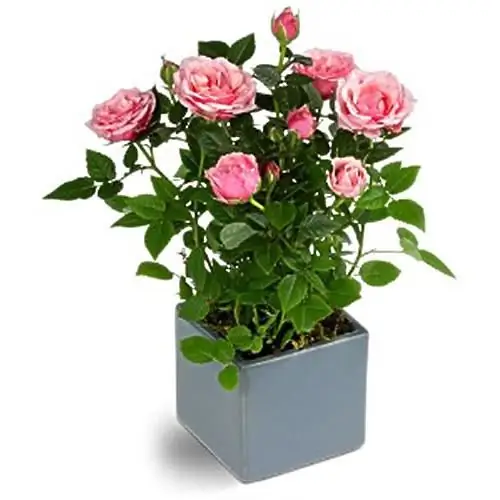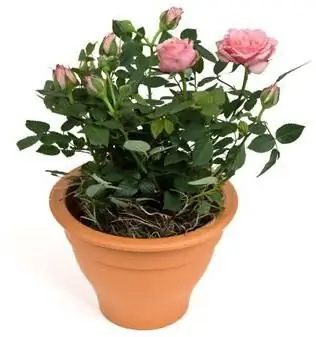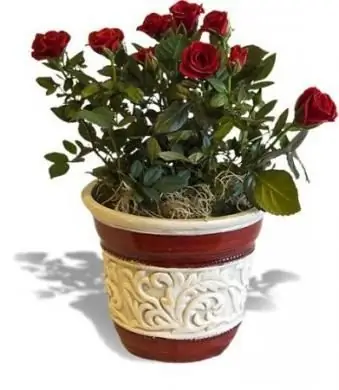Surely flowers live on the windowsill in every house. Someone prefers cacti, and someone more familiar - "ours". But any person, without exception, would not refuse to become the owner of a tiny rose in a pot. It blooms all year round, delighting the household with a delicate aroma and pleasant appearance.
There is a belief that caring for a room rose is unusually difficult. Actually it is not. A prerequisite is, of course, providing the flower with the conditions necessary for life. To learn about them, you need to have some information. And first of all, you need to find out where the homeland of the room rose is located.

What is an indoor rose
Indoor rose is a miniature plant that has the same structure as an ordinary garden. Every self-respecting gardener should have some knowledge about their plants. The birthplace of room roses is the subtropics of Southeast Asia. This means that if you want to become the owner of a beautiful plant, you must provide it with proper care.
The main condition is the grafting of a rose. If this is not done, then in our climate the flower will die. This is understandable, because the homeland of a room rose differs significantly in temperature conditions, seasonal precipitation, and weather conditions.
To survive, the rose needs grafting and plenty of fresh air. These are the minimum conditions under which the flower will delight you with its beauty.
Flowering

The homeland of room roses is the territory where summer is all year round. This also leads to a long flowering of the bush. He only occasionally takes minor breaks. Of course, this also depends on the species.
Those of them that are most adapted to our climate bloom exclusively in the summer. This is explained by the temperature of the air.
The color scheme of the flower is really amazing. It includes a variety of all shades, from black to white. The exceptions are blue and cyan, as well as their variations. If desired, you can create a similar coloring by simply adding ink to water. But you must understand that with such care, the roses will begin to fade. Those who want to have a flower of extravagant colors should take care of it doubly.
Rose care

As an indoor flower, a rose requires special attention. You must be prepared for a lot of hassle and problems. Rose home room requires special lighting, temperature, moisture and watering, because her usual conditions are significantly different from ours.climate.
The room temperature should be above 14-20 degrees. If it falls below 10 degrees, then the flower falls into a dormant state, and the flowering process stops. The birthplace of room roses is the subtropics, where the temperature is maintained at a fairly high level all year round.
Watering is a special chore. Rose in room conditions is very afraid of drying out and waterlogging. It is very important to water the flower regularly and at the same time. The period of activity should be accompanied by abundant watering. However, you should be careful and not overdo it. During dormancy, watering should be moderate.
Lighting is also due to many nuances. Indoor rose flower is very fond of light and heat, but in direct sunlight it gets burned. That is why in the house it should be placed on the western or eastern side, so that it receives maximum light, but there is also shading.
The homeland of room roses suggests completely different conditions for its cultivation. Those who want to have a wonderful flower should bring them as close as possible. Vaccinations, of course, contribute to acclimatization, but are not able to turn the Chinese rose into "our" plant completely. The Chinese indoor rose loves moisture very much. It should be sprayed regularly from all sides. Sometimes a rose can be washed in the shower. In the very room where the flower grows, humidity should be above 50%. If this is not done, then the appearance of a spider mite will become possible.

Diseases and pests
Chinese rooma rose, like any other flower, is not immune from the appearance of pests and various diseases. The most dangerous and unpleasant ailments are the black leg and the spider mite. Indoor rose (the birthplace of the plant also provides for specific diseases) requires proper care to avoid diseases.
Spider mite
Spider mite is a carrier of dangerous diseases. He settles on a plant and sucks the life out of it. The leaves of the plant turn white and eventually fall off. You can get rid of it. It is necessary to treat the leaves and flowers with an infusion of garlic water or special insecticides. You need to do this at least four times. To prevent such a parasite from starting, you should regularly spray the plant and keep the humidity at a sufficient level.
Black leg
Black leg is one of the most dangerous types of soil fungus. It usually affects plants that are weak and unadapted to the climate. It can appear if watering is too plentiful, or the temperature in the room is low enough. The action of this parasite is immediately visible - the base of the stem and the root collar turn black. At the first sign, serious measures should be taken, otherwise the plant may die. Initially, you should water the flower with Fitosporin or a solution of ordinary potassium permanganate. If this does not help and the rose is not cured, he althy cuttings should be cut. Thanks to them, the rose is rooted again in new soil. The pot should be thoroughly washed with laundry soap, and the old earth should be disposed of.
Transfer

Roomrose (the birthplace of the plant has a special soil) requires regular transplantation. This is usually done in early spring. The method is transshipment. It should be remembered when choosing a soil that the rose actively uses substances from it. That is why it is necessary to select the most nutritious earth mixture. This is sod-humus or sod-clay. If it is not possible to find it, you can use a mixture of peat, earth and sand.
The choice of a pot is equally important. It should be at least a couple of centimeters larger than the previous one, and have several holes at the bottom. A prerequisite is its light color. This will ensure that it will heat up less, which will have a beneficial effect on the flower itself. About one centimeter of expanded clay is poured at the very bottom of the pot.
Resting period
Chinese indoor rose has an obligatory dormant period in its cycle. Most often, it begins in mid-autumn, when flowering ends. Then the plant must be transferred to a cool room, the temperature in which should be below 10 degrees. The optimal range for the rest period is 6-8 degrees. In apartment conditions, keeping a room rose during the dormant period causes most of the problems.
In winter, the apartments are well heated, and finding a suitable place where the temperature is low enough is very difficult. Probably, almost the only option for keeping such a flower in an apartment is a glazed balcony.

It is very important to provide the rose with warm soil. For thisit will be enough to put the pot in a box with sawdust. You should regularly check the temperature on the balcony so that it does not fall below 6 degrees. If this happens, then a black leg may appear, which contributes to the weakening of the plant.
Water at rest should be moderate. Spraying the bush is not worth it at all. If everything is done correctly, then in March the flower will delight you with buds.






